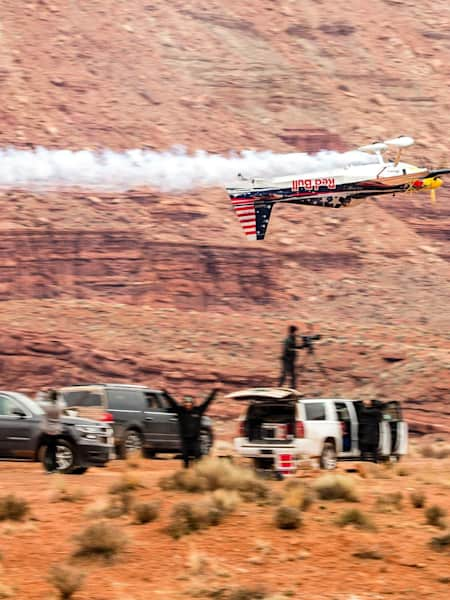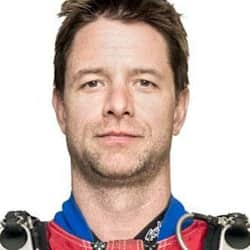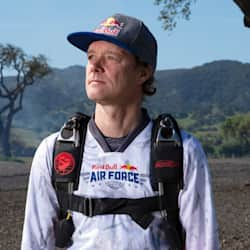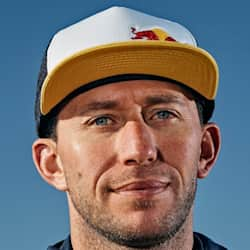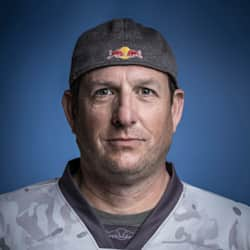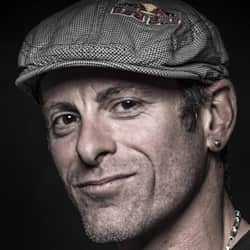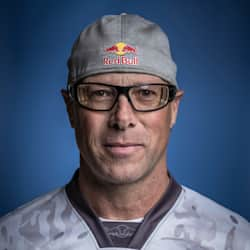First things first: if you haven’t seen the Red Bull Air Force’s “Chain Reaction” video, you need to watch it now. We’ll wait … OK, so now that you’ve seen it, you probably want to know more about it, and you’re in luck — we have an awesome behind-the-scenes video below, along with more insight from RBAF Captain Jon DeVore under that. Plus photos. Enjoy!
Go behind the scenes of Chain Reaction in the video below:

7 min
Red Bull Air Force Mega Edit - Behind the Scenes
Get the story behind the filming of the Red Bull Air Force's Chain Reaction aerial sports project.
Read on for more details about the project, straight from Jon DeVore:
The Red Bull Air Force
We’re not just a one-discipline team. We’re not just skydivers, just BASE jumpers, or just air sport athletes. We also have people on the team like Kirby Chambliss, who is a world champion aerobatic and Red Bull Air Race pilot. We were able to take everyone’s different skills and combine them and showcase to the world that we have every discipline in air sports covered on our team, and we have world champions in every discipline.
You lose 2-3 degrees every 1,000 feet you go up, so we were in below-zero temperatures, with wind chill way colder than that.
The location
To find the right location for this project was challenging. After a lot of research we came to the conclusion that Moab was going to be the perfect location to accomplish our goals. It’s a place where extreme sports athletes from all around the world come to do everything from air sports to rock climbing. It allowed us one location to give us everything we needed to go from A to Z in this whole sequence. Not to mention it’s one of the most unique places in the world. When you see a picture of Moab, you know that’s what you’re looking at because there’s nowhere else in the world that looks like it.
The plan
Planning and coordinating this whole sequence was a massive undertaking that took about six months. When we had the green light for this project, it fell on our shoulders to figure out how all the pieces of the puzzle fit together.
The first stage was to find the right equipment. In recent years, a few of the manufacturers started producing a new breed of high-performance parachute. These parachutes fly at such a steep angle and high rate of forward speed that top athletes around the world started realizing that with the right practice and right wingsuit design we could fly parachutes and wingsuits side by side and match speeds, but it isn’t an easy task. It took a lot of training. We got the team together in advance a few times and rehearsed the overall concept to make sure that it was going to work before we brought Kirby and his race airplane into the mix.
The challenges during shooting
On the first attempt, it didn’t run very smoothly. It was just a timing issue; we were trying to put together a lot of different pieces at the exact same time, which nobody’s ever done before. We’re combining people in freefall deploying really high-speed parachutes, wingsuit pilots who are chasing an airplane, and an airplane having to fly in circles with people in freefall. So the first attempt just didn’t go right, we weren’t able to synch up.
Then Kirby had a technical malfunction with the aircraft — the gas tank cracked, so he was done for the rest of the day. We knew we only had the rest of the day to perfect our part of it because we were going to get Kirby back the next day, but for one or two takes at the most, so we had to stick it.
The light
One of the big concerns that we had after looking at the light and thinking about how everything had to go down on the day of the shoot was that there was going to be a balance we had to find. The ideal light for the cinematographers was when the sun came up and crested on top of the cliff. But for the BASE jumpers, it would have been unsafe to jump that soon because they wouldn’t have been able to see the cliff face. As the sun came up, we realized we’d eventually each have the perfect light, but only for a short, 15-minute window. So we had one chance to get it right. It was a lot of planning leading up to it, a lot of us all talking through how each part of it was going to go. We had a perfect plan and we executed it.
The cold
When we first identified Moab as the location, everybody was like, “Great, it’s going to be warm like a desert,” but when we showed up we realized that it was high desert and it was freezing out there. There was snow on the ground and it was way colder than anybody expected. It was already below freezing on the ground, so it made us quite concerned about what it was going to be like 15,000 feet up. You lose 2-3 degrees every 1,000 feet you go up, so we were in below-zero temperatures, with wind chill way colder than that.
We couldn’t bundle up, because the wingsuits are built specifically for your body size. We had to figure out how to stay warm, and most importantly how to keep our hands warm. When it’s time to pull your parachute and you have numb hands and can’t feel anything, that could be a very dangerous situation. We had heat packs in our gloves like we were going big mountain skiing.
The timing
I went in very confident because I’d worked with the guys on the team for many, many years, and we’re a well-oiled machine. But we’ve never tried to put all these pieces together in one continuous jump. It was nerve-wracking.
One of the biggest challenges for the timing on this project was to link up Kirby in his airplane with our jump helicopter. Those are two completely different machines. The helicopter could go fast enough for Kirby to fly with him, in theory, but for us to climb out and hang out on the skids we need a slower speed or we’d just get ripped off the side. That created a massive challenge for Kirby, because his plane doesn’t fly that slow — it stalls.
So we had to find this balance, to fly just fast enough that Kirby could come up next to us and make eye contact and give us an authentic countdown to the chain reaction. It was a very adrenaline-building moment, because Kirby came up and you could see he was doing everything possible under the moon to stay with us. Watching that and knowing that we were on this thin-ice borderline of this even being possible, it made us realize that we better stick our jobs, because Kirby’s sticking his right now. It was an intense moment.
The safety consideration
When we first started developing the idea, knowing that so many firsts were going to happen in combining all these disciplines to work together, my biggest concern was how to do it safely. We took a lot of measures to make sure we went into it as safely as possible. Obviously our sport is a bit high-risk, but if you check all the things off your list, you can mitigate that risk and actually make it quite safe.
We researched the right wingsuit and parachute that would fly together the best, so we wouldn’t have one guy pushing the envelope of his piece of equipment while the other one was having to put the brakes on. We wanted everything to match as well as possible so everybody had a lot of range in case we needed to get out of trouble at any point.
In addition to this, we needed to have a special type of skydive container developed. It is illegal to jump a traditional BASE rig — a single-parachute system — out of an aircraft. So with this in mind we needed to have a skydive parachute system built that would meet legal requirements but also operate like a BASE system. This allowed us to fly our wingsuits by the cliff edge safely, with two parachutes just like you would have if you were traditionally skydiving.
Those are examples of just some of the safety measures we employed for this project to make sure we had every tool in the industry at our disposal so we could walk away high-fiving.
The dream realized
The Chain Reaction project was a dream come true for everybody on the team. We’ve talked about something like this for many, many years. So to have the sponsors and the right creative come together, our stoke level went through the roof. There could have been no better end to 2015 than to have Chain Reaction come together and be exactly what we dreamed it to be. We walked away proud.
Part of this story

